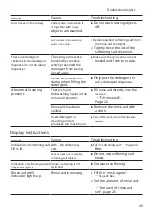
Troubleshooting NL
Malfunction
Cause
Troubleshooting
There are colored (blue,
yellow, brown), difficult
or non-removable
deposits in the interior of
the appliance or on
stainless steel dishes.
Layering occurs due to the
components of vegetables
(cabbage, celery,
potatoes, noodles, ...) or
tap water (manganese).
▶
Clean the device.
You can remove the deposits with a
"mechanical cleaning"
Page 36 or
remove a machine cleaner. The
deposit can not always be
completely removed, but it is not
harmful to health.
Metal components
cause filming on silver
or aluminum crockery.
▶
Clean the device.
You can remove the deposits with a
"mechanical cleaning"
Page 36 or
remove a machine cleaner. The
deposit can not always be
completely removed, but it is not
harmful to health.
There are colored (yellow,
orange, brown) deposits
that are easy to remove
in the interior of the
appliance (especially on
the bottom).
Layers are formed by
components of food
residues and tap water
(lime), 'soapy'.
1.
Check the water softening
setting.
2.
Top up with softening salt.
3.
If you use combination
detergents (tabs), activate the
water softening.
Follow the directions for the
detergents.
Plastic parts inside
the appliance are
discolored.
Plastic parts in the
interior may discolour
during the life of the
dishwasher.
▶
Discoloration may occur,
but they do not adversely affect
the operation of the appliance.
Plastic parts are
discolored.
Washing temperature is too low.
▶
Select a program with a high
re wash temperature.
Crockery has been pre-
cleaned too well. The sensor
system therefore opts for a
weak washing program.
Stubborn dirt cannot
be partially removed.
▶
Only remove coarse food residues
and do not pre-rinse the dishes.
There are removable
smudges on glasses,
glassware with a metallic
appearance and cutlery.
The amount of rinse
aid is set too high.
▶
Set the rinse system to
a lower position.
47














































